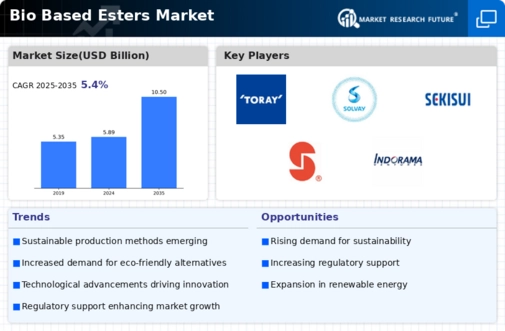Market Growth Projections
The Global Bio Based Esters Market Industry is projected to witness substantial growth in the coming years. With a market value expected to reach 5.89 USD Billion in 2024 and an anticipated CAGR of 5.37% from 2025 to 2035, the industry is poised for significant expansion. This growth is driven by various factors, including increasing demand for sustainable products, regulatory support, and technological advancements. The market's trajectory suggests a robust future, with potential applications across multiple sectors, reinforcing the importance of bio-based esters in the global economy.
Growing Demand for Sustainable Products
The Global Bio Based Esters Market Industry is experiencing a surge in demand for sustainable products as consumers increasingly prioritize eco-friendly options. This trend is driven by heightened awareness of environmental issues and the need for alternatives to petroleum-based products. For instance, bio-based esters derived from renewable resources are being utilized in various applications, including personal care and automotive industries. This shift towards sustainability is expected to contribute to the market's growth, with projections indicating a market value of 5.89 USD Billion in 2024, reflecting a significant opportunity for manufacturers to innovate and expand their product offerings.
Expanding Applications Across Industries
The versatility of bio-based esters is fostering their adoption across diverse industries, thereby driving growth in the Global Bio Based Esters Market Industry. These esters are increasingly utilized in sectors such as food and beverage, pharmaceuticals, and coatings due to their favorable properties. For example, bio-based esters serve as effective solvents and plasticizers, enhancing product performance while minimizing environmental impact. As industries seek to replace conventional materials with sustainable alternatives, the demand for bio-based esters is expected to rise, further solidifying their market presence.
Regulatory Support for Bio-Based Products
Government regulations and policies promoting the use of bio-based products are playing a crucial role in the Global Bio Based Esters Market Industry. Various countries are implementing incentives and subsidies to encourage the production and consumption of bio-based materials. For example, the European Union has established stringent regulations aimed at reducing carbon emissions, thereby fostering the adoption of bio-based esters in various sectors. This regulatory support not only enhances market growth but also aligns with global sustainability goals, potentially leading to a market valuation of 10.5 USD Billion by 2035.
Rising Consumer Awareness and Preferences
Consumer awareness regarding the environmental impact of products is influencing purchasing decisions, thereby benefiting the Global Bio Based Esters Market Industry. As consumers become more informed about the benefits of bio-based esters, such as biodegradability and lower toxicity, they are increasingly opting for products that incorporate these materials. This shift in consumer preferences is prompting manufacturers to reformulate their products to include bio-based esters, thus expanding their market reach. The growing inclination towards sustainable consumption is anticipated to propel the market towards a valuation of 10.5 USD Billion by 2035.
Technological Advancements in Production Processes
Innovations in production technologies are significantly impacting the Global Bio Based Esters Market Industry. Advances in biotechnology and chemical engineering are enabling more efficient and cost-effective methods for producing bio-based esters. For instance, the development of enzymatic processes has improved yield and reduced waste, making bio-based esters more competitive against traditional petrochemical products. These technological advancements are likely to drive market growth, as they enhance the feasibility of bio-based esters in various applications, contributing to a projected CAGR of 5.37% from 2025 to 2035.
















